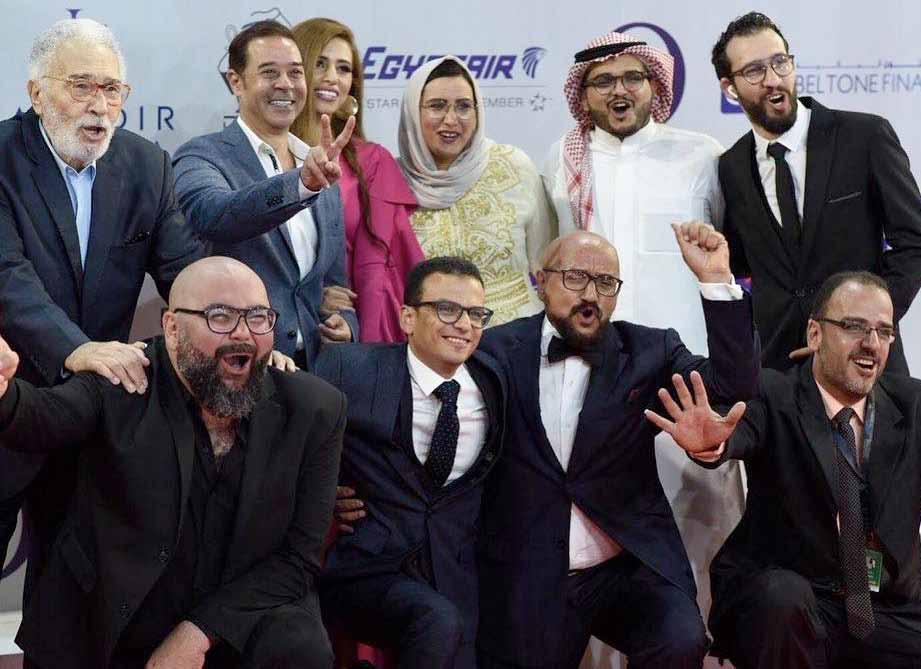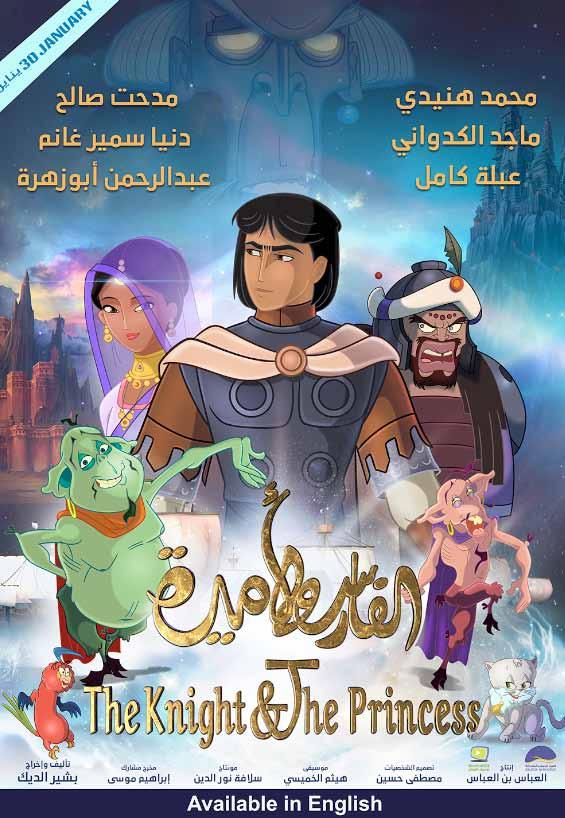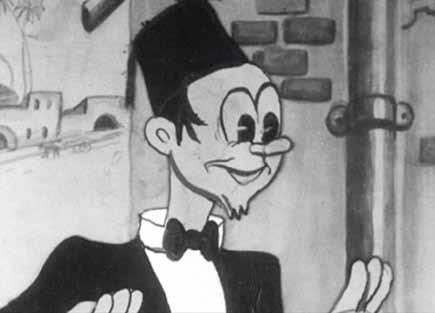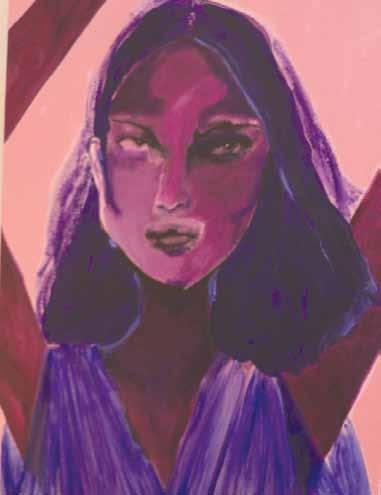
18 minute read
Animating Egypt
ulture C
Animating Egypt
How One Saudi Producer Spent the last 20 Years Reshaping the Industry
by Yasmine El-Geressi
Egypt was the first in the Arab world and Africa to establish an animation production. In 1934, the pioneering brothers Solomon, David and Frankel Herschel (recent immigrants from Soviet Belarus) who, despite their limited technical capabilities and resources, introduced Egypt’s answer to Disney’s Micky Mouse, Mish-Mish Effendi, in their film Nothing to Do. “David drew thousands of pictures, and Shlomo invented a device that enabled them to screen films to viewers without a special hall, it was something of a premature television set, made of a box, celluloid film, and a lantern to reflect the shots on a small screen. It also included a portable speaker that played the sound.” Nephew Isaac Rosenblum recalls, in the documentary Bukra Fil MishMish. Mish-Mish Effendi became a national star and was able to compete globally. The cartoon would even go on to include legends of the era, such as the Lebanese singer Sabah and Egyptian bellydancer Tahiya Karioka. Egyptian companies hired the Frenkel brothers to produce commercials with the character, the government used him for propaganda, the ministry of agriculture purchased a tutorial film in which Mish-Mish teaches people how to cope with cotton crop parasites. Just before World War II, the ministry of defense asked for a film calling the Egyptians to strengthen the army. The Frenkel brothers were even awarded a national medal. Animation continued to flourish in Egypt in the 1960s, when Ali and Husam Muhib, arts graduates leading a group of fellow illustrators and filmmakers, began producing a few low-budget films before taking charge of the animation department in the newly established Egyptian television. The main obstacle facing the Mohib brothers was the lack of trained artists, which forced them to do their best to train some of those who would later become animation professors at the Higher Film Institute and the Faculty of Fine Arts. In 1962 the Mohib brothers made The White Line, their first long film which, produced by Egyptian Television, was a mix of live action and animation techniques, as well as the first Arabiclanguage animation series, the thirty-episode Mishgias Sawah in 1979. The brothers became the most influential figures in animation production until the 1980s, though most of their work remained limited to advertising and propaganda with a few short films, animated series and songs. As Egypt’s animation facilities expanded more diverse work had a chance to thrive – such as Zeinab Zamzam’s Islamic-themed clay animation film using old-fashioned Claymation techniques (A Terra-cotta Dream, 1997;
Cast of the animated movie The Knight and the Princess (Supplied)
Open Your Eyes, 2000). Egypt witnessed an expansion of animation facilities during the 1990s and 2000s. In addition to programs at universities, such as the one started by Ghazala at Minya University, there are at least 10 significant animation studios—including Abou El Nasr’s Cairo Cartoon Studio and Zamzam’s Zamzam Media—operating and producing animations for television, commercials, and the occasional short film. Much of this material is shown in other parts of the Arab world, and some are co-productions with Gulf states. (Historical Dictionary of Middle Eastern Cinema, 2010) In 2010 Mohamed Ghazala won the Animation Prize at the African Movie Academy Awards in Lagos, Nigeria. His was his country’s only representation in the entire competition, a three-minute cartoon entitled Honayn’s Shoe. Given this long and rich heritage, the scarcity of animation films produced, as well as homegrown animators in Egypt is surprising. But one man is on a mission to animate Egypt and the Arab world. After 20 epic years in the making, Saudi film producer Abbas AlAbbas premiered Egypt’s first animated feature film, and the first ever animated film created exclusively by Arab talents “The Knight and The Princess” at the ElGouna Festival in September last year. “Producing an animated feature film

for any first time producer is not an easy task, almost impossible if your production cast also have not gone through such production previously.” he told Majalla. Yet, with a “strong heart and great passion”, Alabbas was able to withstand substantial challenges as the horizon of his wildly ambitions vision stretched for two decades until he was able to turn what seemed like a distant dream into a colorful reality. The seeds for what quickly became Alabbas’s “lifetime goal” were sown when he as studying in America for his degree in Industrial Engineering and Engineering
ulture C
Administration and his son was almost 5 years old. Alabbas noticed the increasing influence effect cartoons had on the minds of children during their formative years. One particular cartoon, He-Man, ‘the most powerful man in the universe’ who goes against evil forces to save the planet, fascinated his son and he began to idolise the leading character. Although cartoons are entertainment, they also act as powerful education platform education platform for children who often absorb a lot from their favorite cartoons – they learn about their own culture, about values and mortality in their society, and about what makes a character a good or bad person. As such, Alabbas wanted the stories that would shape his son’s childhood memories to be embedded with aspects of Arab culture that are in sync with his real environments. “I wanted him to see other animation stories and heroes from our culture so I decided to go to Egypt to see what is available for my son. I was surprised that there were absolutely none. I found it frustrating and appalling that we don›t have anything for our children to see their culture, their heroes and themselves represented in the series they watch,” Alabbas explains. Armed with a mission to introduce young Arabs to key facets of their culture and identifiable characters to which they can look up to, but not much else, Alabbas knew he had to start somewhere, so he spoke to his adviser at George Washington University about his newly found aspiration and he agreed to give him the opportunity to take a self-study research course in amination which a friend of his working in the animation business would grade. With his unmistakable mix of unbridled enthusiasm and serious talent, Alabbas graduated with a 4.0 out of 4.0 GPA.

“After graduation I went to Egypt and established the Alsahar Animation Company. I spent two years training and building experience for the animators before we got our first series for the Arab Radio and Television kids channel. We then made animated series for Egyptian, Saudi and Qatari television, the MBC network, and many others. But all the series were made to the tune of the TV channel producers who dictate the story, the production timeline and the budget,” Alabbas recalls. After learning some hard lessons about the animation industry, in 1998, Alabbas decided it was time to take things to new heights. “We decided we will venture to make the first animated feature made entirely by Arab talents,” he said. First, he began searching for a riveting story from Arab history that revolves around a hero that could “speak to a young generation” and would appeal to children’s appetite for adventure and. When Alabbas and his team came across the story of 7th century Iconic Arab warrior Mohammed Bin Alkassem, who’s story is packed with
30 21/02/20 The Knight and the Princess film poster (Supplied)
Mish Mish Effendi, an Egyptian cartoon hero.
all the components of animated classics – a hero, pirates, a love story, villains and a great adventure -they knew immediately that they had uncovered a gem. “The story follows the amazing journey of a -15year-old knight who saves women and children from pirates on the north Indian shores, finds his love and decides to free Sind from the tyrant king Daher.” They then brought in one of the country’s best scriptwriters and directors, Basheer Eldeek, and the late cartoonist Mustafa Hussein. Next, Egyptian stars from past and present, such as Mohamed Henedy, Maged ElKedwany, Medhat Saleh, Donia Samir Ghanem, Amina Rizk, and Ghassan Matar, recorded the voice overs for the movie’s characters. For an indie studio, this was a huge expense. When it came to the production stage of the movie, the budding producer found himself trapped between the paucity of talented home grown animators and a lack of funding. He quickly realised that if he wanted to dream big, he would have to think ever bigger, and this would require redesigning the landscape of the industry. “We tried to get financing for our project but no one was ready to invest money in an industry that is dominated worldwide by Disney, but I was not ready to give up and took the decision to do it slowly but surely. We continued with the production of the film while also doing working on animated series for TV channels to help us finance the feature film production. When we would gather enough funds we would complete a minute or so. 2D animation is extremely costly. A second has between 25 and 25 frames and if there are numerous backgrounds that could add up to 100 different drawings per second,” the Saudi producer said. Alabbas explains that on top of having to stop production whenever they would run out of money, they also had to

train and develop animators throughout decades. “Animation production is costly and time consuming by the nature of the medium, it needs a strong heart and great passion to risk your time and money. Working with Arab staff increases the risk of trial and error at every step of the production hence the overall budget expense and the many unmet deadlines. We had an advantage, we had a dream, dreams don’t measure costs require passion to make them come true.” The 20 years Alabass invested – on and off- were well spent. Following its world premiere at ElGouna festival last year, the film won major plaudits. “We are proud to showcase the first Egyptian animated feature film created by an Arab crew, whose work is on par with prominent animated films from around the world. The film not only represents a significant milestone for the Arab film industry, but also helps it take crucial steps towards expanding its horizons through a genre that embodies creativity, imagination and talent in a brand new light in the region,” commented Intishal Al Timimi, director of El Gouna Film Festival. The film also made its way to the 9th Malmo Arab Film Festival in Sweden last October. “The Knight and the Princess” has been chosen to open the 19th edition of Meknes International Animated Film festival in Morocco between February 20 and March 2. The festival, which is organised by the Aicha Foundation in partnership with the French Institute of Meknes, is the biggest animation film festival in the region, attended by thousands of passionate animated film fans from around the world. In its 19th edition, the festival has chosen Egypt as it’s guest of honor as it celebrates the 85th anniversary of the release of the first Egyptian and African animation film Mish-Mish Effendi, in the presence of over 30,000 animation film enthusiasts. I hope that honoring Egypt’s illustrious animation history by celebrating another momentous milestone in the industry will inspire more young people in the region to look to people like AlAbbas who are trailblazing a path for other aspiring animators and creatives in the region and believe that no dreamer is ever too small and no dream is ever too big.
rt A
From Controversial Social Commentary to Nature Portraits, Parallax Had Something for Everybody Parallax Art Fair Brings Artists from Differing Backgrounds Under One Roof
by Ali El Shamy
First held in 2010, the Parallax Art Fair is an annual art exhibit that prides itself on being run by artists rather than a corporation. Since then, the fair has grown to become one of the most anticipated art events in London, as painters and sculptors from all around the world are invited to display their art pieces to aficionados and potential buyers. This year, I had the pleasure of attending the art fair in Kensington Town Hall (which has been the venue of the event since 2018), where I met a number of talented artists who spoke to me about their work and their journey in becoming artists.
AMY BEAGER PAYS HOMAGE TO LATE DANCER ISADORA DUNCAN
One of the first artists I talked to was Amy Beager, who started her career as a fashion designer rather than an artist. Even though she studied art in college, she told me that she eventually made the switch to fashion design and would go on to work for that industry for seven years. While this was a steady job for her, she decided to follow her passion for art. She left her career and started freelancing while she was setting up her art company, and her hard work paid off as she has been displaying her artwork throughout a number of different galleries for the past year. As the saying goes, fortune favors the brave and although Beager was taking a risk it worked out for her in the end. The art series she displayed was entitled “Mother” which features a number of acrylic and ink paintings that depict major life events from Isadora Duncan’s life. Duncan was a pioneering dancer from the early 20th century who is widely recognized as the “Mother of Modern Dance” and despite enduring many tragic events in her life, she was determined to live her life to the fullest and follow her passions. Beager told me that she finds a lot of inspiration from Duncan’s life and performances, which is why she dedicated an entire art collection to her. Some of the paintings she had on display included Celestial and Dancing Girl. Beager’s work will also be on display at the Roy’s Art Gallery which will be held at the Oxo Tower Wharf in London from 5-2 April.
ESAM HAMZEH USES ART TO OVERCOME TIMES OF TROUBLE
Esam Hamzeh is an artist from Homs, Syria. Her talent in art started from a young age as she studied it during her primary school years. However, she abandoned art
Celestial by Amy Beager

Hansson›s Portiat on Islamist Terrorism

to work as a hematologist. She would eventually move to London where she was doing a Ph.D. course. Things seemed to be going well for Hamzeh, but unfortunately, tragedy would strike her life in 2000 when kidney failure caused her to lose two of her kidneys, which meant she had to rely on kidney dialyzes to survive. Her health problems caused her to stop her Ph.D. studies, so in the face of such adversity, she turned to her old passion for art to ease her anguish. Most of her paintings are of nature, buildings and she also has some abstract work in her portfolio. In 2007, she participated in her first art exhibition at St. George’s Hospital in London, and
The Dancing Girl by Amy Beager.

she donated her proceedings to kidney disease research. This year, her work will also be featured in the Chelsea Art Society Exhibition.
IBRAHIM YASSIN BRINGS INK TO LIFE
Yassin is a Kurdish artist originally from South Kurdistan but is currently based in Denmark. Like most artists I spoke to, art wasn’t his initial career path, he was in fact a chemistry instructor working at the University of Mosul. However, during those years he pursued art as a hobby and in 1990 displayed some of his work at an exhibition at Mosul University. He moved to Denmark in 1996 and would stop his pastime two years later. In 2013, he would pick up art once again and his determination is strong as he has been continuing painting beautiful portraits for the past seven years.
Most of his artwork consists of ink paintings, although he has some watercolor works in his portfolio. He also exhibits his Kurdish identity in some of his work, as he incorporates characters and poetry from the Kurdish language into his paintings. This is his first-ever art exhibit in London, and his work will be on display in three other art shows in Denmark, 2 of which will be in Copenhagen and one in Horsens.
MARIANA GUMENIUC’S ETERNAL FLAME OF PASSION
Hailing from the Republic of Moldova, Mariana Gumeniuc’s artistic journey started when she was 12 years old when she showed exceptional talent in painting and even started her own painting school at that age. Circumstances forced her to stop pursuing art at the age of 14, but that passion never really went away. When she moved to London, her passion came back with the ferocity of a typhoon as she amazingly painted 75 paintings in the span of fewer than three years. She

eloquently portrayed this everlasting passion in her painting “Eternal Flame” which is a metaphor the flame that remained in her mind even after all those years of not doing any artwork. Some of the art she had on display had some social commentary, for instance in her painting “Behind” she shows a man’s face in front of that of a woman’s to show that even in societies where a man is always at the forefront there is always a woman behind him. Moreover, even though the woman in the painting is behind the man, there is a clear 50/50 split in the space both faces take up, showing her belief in equal rights for both genders. Other paintings are more personal, for instance, “Don’t Let Me Down” symbolizes a time in her life when she was feeling great anguish and stress from the pressures of balancing her work and raising a new child. However, as this painting is made with warm
Esam Hamzeh›s Flower Portraits.
When Mariana Gumeniuc moved to London, her passion for art came back with the ferocity of a typhoon as she amazingly painted 75 paintings in the span of fewer than three years.

Behind by Mariana Gumeniac.

colors, she shows that even in times of great strife there is always hope that things will get better soon.
JORGEN HANSSON: NOT AFRAID OF CONTROVERSY
The artist from Sweden had one of the most controversial art collections on display: “Tipping Points”, and many of his pieces can be considered offensive to some onlookers. The main idea behind “Tipping Points” was to portray events and phenomenon that in his view changed global sociopolitical landscapes. His most bewildering piece in the collection is an abstract painting that portrays Islamist terrorism, arguably most eye-catching part of the painting is the World Trade

A Piece from Evan Wu Siu Ping›s Revivification Collection. Eternal Flame by Mariana Gumeniuc.

Center being hit by airplanes, the painting also shows Qasem Soleimani’s face with a US flag target painted over him. Further inspection of the painting reveals other examples of Islamist terror, such as convoys carrying the flags of IS. Other paintings include one called “Plastic Ocean” which shows a small portrait of Greta Thunberg and one on the #MeToo Movement. Hansson told me that he felt that he had to choose controversial art pieces so that he could leave a mark on people participating in the exhibition. His other hobbies include novel writing, but he had to abandon the activity in favor of painting two years due to his vertigo making it difficult for him to write. The art show proved to be a great success for Hansson as two other exhibitions showed interest in displaying his art pieces.
EVAN WU SIU PING APPRECIATES SHORT-LIVED BEAUTY
One of my favorite art display’s was Evan Wu Siu Ping’s “Revivification”. At first glance, the art pieces seem to show colored paper cut and folded to show butterflies, but upon closer inspection, you can that the paper Evan used actually came from magazines. She did this to make a metaphor comparing the short-lived beauty that is found in both the natural and commercial spheres. Butterflies are colorful, beautiful creatures that have short life spans, similarly magazines are beautifully designed colorful pieces of media that can bring great enjoyment to readers. But like butterflies, magazines have short shelf-lives and are discarded by humans.
A Weekly Political News Magazine
Issue 1788- February- 21/02/2020

Mohammed Tawfiq Allawi: Iraq’s New Prime Minister is On a Mission to Curb Corruption







